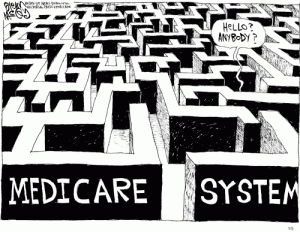Virtually every marketing book and many articles will advise you to tap into your customers Zen.
They will tell you to figure out what they want, how they want it delivered and what they are willing to pay for it. While this can be valuable information, it can also be a handcuff that limits creative, innovative thinking.
Last week I talked about how staying within the norm, is a significant barrier to innovation in Senior Housing. This week I want to talk about how your prospects can steer you wrong.
A Story . . .
I love potato salad! Growing up my mother made great potato salad. I got married and my wife also made great potato salad, and by adding mom’s secret ingredient it became the best potato salad in the world. Potato salad takes a fair amount of effort to make and so was reserved for a few special occasions each spring and summer.
She would have made it even more often except that our six year old son could not stand potato salad. We would beg him, plead with him, bribe him and at times even threaten, in an effort to get him to eat the best potato salad in the whole world.
It was a futile effort, he would not allow the tiniest taste to pass between his lips. Then one Sunday morning he came crawling into bed with us and as he climbed into bed we could smell something on his breath. Yep, he was up before us, and hungry, he knew better than to wake us on the one day we could sleep so he went looking for something easy to eat.
There on the bottom shelf where he could reach it was the leftover potato salad. In an act of foolish desperation he grabbed a spoon and took a taste he was hooked. Asking him what he wanted would have never in a million years lead him to potato salad.
Why Senior Housing Consumers Often Get It Wrong
Senior housing consumers only know what they have seen and been told. Which means their expectations, their desires will always fall in the norm. Even this is not quite right . . . the 90% of eligible seniors who choose to not take advantage of senior housing make that decision because “the norm” does not meet their expectations and desires.
While they are not able to tell you why, the one thing they do know is that it is not for them. Consumers will almost never be able to tell you how to innovate and that is not their role. They can’t experiment or explore. They can only tell you what they like and what they don’t like based only on what they have seen.
Perhaps what is even more scary is the reality that consumers will tell you what they like and would be willing to buy, then when you actually offer that thing for sale, they will not actually buy it.
When Rush Limbaugh started his syndicated national radio show he had a fairly easy time getting airtime, because everyone knew that “middle of the day” play slots had little value. Yet for something like 25 years running he has dominated the syndicated radio market place. No focus group could have ever told him that.
What this means to Senior Housing
1. Most of the really good ideas already exist – What I mean by this, is that while it may not look like it, the most revolutionary ideas in senior housing are already being done by someone. They may not be done right; They may need some tweaking, some refining, but they are already out there in some shape or form.
2. Innovating means taking some risks – This does not mean taking foolish risks. Take a look at what people are doing and figure out how to do it better. Try it in one community or in one part of a community and see what happens. If the results are not quite what you hoped for, examine it for ways to make the idea better before abandoning it. If you discover that it just doesn’t work the way you wanted it abandon it quickly and do something else.
3. Much of innovating is remixing existing ideas – Take two or three ideas and meld them together to create something even better. Talk to people who are doing cool stuff and ask them why they are doing it, how it is going and how they came up with the idea.
4. Innovating will take conversation and collaboration – This means we need to be talking to each other about what works and what doesn’t. We need to share our failures and our successes. This may seem counter intuitive in a competitive environment, but honestly, if we were doing this well, we would increase the market penetration where not only every community would be full, but there would be seniors standing in line to get into our communities.
Don’t miss a single issue of Senior Housing Forum, subscribe today. It is free! We do not sell or share your contact information. The posts are practical and never too long.
Go to the main page of Senior Housing Forum and on the right hand side you will see a place to enter your email to subscribe. You will receive notification when a new article is posted. You can unsubscribe at any time.
Finally: If you know anyone who is looking at emergency call systems I would appreciate the opportunity to talk with them about Vigil Health Solutions.








From LinkedIn Groups
Steve, great article and I think really thought provoking. I remember a discussion with an official from the federal government and their response to surveys that over 90% of those who spend time in a skilled facility would recommend their location to others: “That is because the customer does not know any better.” This answer is right in-line with your write-up. Much appreciated!
Posted by Rob Liebreich
From LinkedIn Groups:
Great topic, Steve. What I get from the article is a great reminder: it’s certainly true that a particular community is not going to be a perfect fit for absolutely everyone who walks through the door–maybe they want a downtown-location and yours is 5 miles away…maybe they want more IL and yours is more AL, etc. But for those who the community WOULD be right for, by the time you arrive at the “closing” of the tour experience there will often be two sales teams in the room: the community’s representative looking to get the check…and the family who will try to “sell us” on why it’s not time, it’s not for them, they’re not ready, it’s someone else’s decision, we’re too expensive, there are 6 more places to look at…and on and on!
As the article states, those who say “it’s not for me” did not see or feel that the community met their expectations or desires. But, oh, how often do we know that our community DOES meet their needs–so either they didn’t experience what they needed or it’s something else (the intangible objection). As much as perception can be reality, the keys to success are certainly in the discovery process and tour experience (among other things).
The visitor/inquirer may not yet know exactly what they’re looking for, but they’ve visited or called so it’s our opportunity to help them identify it…and also learn what their expectations/desires/pre-concieved notions are to “open the door”. If the visitor/inquirer wants a predominantly independent living lifestyle with a downtown location and we only have the first part of that to offer, they may still choose us IF we learn they place much higher value on the types of neighbors/programs/dining they’ll experience rather than being a short walk from the coffee shop and library…and IF we capitalize on helping them recognize that, and show them our community has it (assuming it does, of course).
It’s just example of not letting the potential customer sell us on their “objections” or “hesitations” especially if we’ve done a good job with discovery and learning expectations and we know we’re a good fit. Again, great article to read (the title really grabbed my attention)–thanks for posting!
Cheers to happy selling and high occupancy…
Posted by Rodney Denman
Steve Moran • Rodney you make a great point with the idea that in fact the community does meet their needs but somehow the marketing/sales effort did not do a compelling job of telling the story.
Steve
Good article…As Henry Ford observed, “If I had asked consumers what they wanted, they would have told me a faster horse.” Instead, he depended on his intuition and a general understanding of human behavior. Attempting to understand older consumers solely through objective research is increasing problematic. As Dr. Antonio Damasio, USC neuroscientist, has documented…the part of your brain you use to make decisions is different from the part of your brain you use to make decisions. Therefore, understanding later life values and understanding that the aging market is comprised of segments of one. I have also observed research reports where the wrong conclusions were made from good information because the researchers were viewing aging through young eyes using youth market paradigms.
Posted by Richard Ambrosius
From LinkedIn Groups
What a great post. Thank you. I recently started a business where I am trying to help to bring computer skills to seniors who would like to keep in touch with people via Facebook, email or other means. When I initially did some research and asked people what they thought of the idea they thought it was great and they knew people who could really benefit from the use of computers. After starting the business I am finding that those leads are not panning out and most seniors are not standing in line for my services either. So I definitely agree with you about the idea of consumers asking for something and then not needing or wanting it after it was offered. I will have to find some ways to be innovative as your article suggests. Thanks again.
Posted by Laurie Dorr
From LinkedIn Groups
Excellent article for senior living!
Posted by Diane Masson
From LinkedIn Groups
Great topic, Steve. What I get from the article is a great reminder: it’s certainly true that a particular community is not going to be a perfect fit for absolutely everyone who walks through the door–maybe they want a downtown-location and yours is 5 miles away…maybe they want more IL and yours is more AL, etc. But for those who the community WOULD be right for, by the time you arrive at the “closing” of the tour experience there will often be two sales teams in the room: the community’s representative looking to get the check…and the family who will try to “sell us” on why it’s not time, it’s not for them, they’re not ready, it’s someone else’s decision, we’re too expensive, there are 6 more places to look at…and on and on!
As the article states, those who say “it’s not for me” did not see or feel that the community met their expectations or desires. But, oh, how often do we know that our community DOES meet their needs–so either they didn’t experience what they needed or it’s something else (the intangible objection). As much as perception can be reality, the keys to success are certainly in the discovery process and tour experience (among other things).
The visitor/inquirer may not yet know exactly what they’re looking for, but they’ve visited or called so it’s our opportunity to help them identify it…and also learn what their expectations/desires/pre-concieved notions are to “open the door”. If the visitor/inquirer wants a predominantly independent living lifestyle with a downtown location and we only have the first part of that to offer, they may still choose us IF we learn they place much higher value on the types of neighbors/programs/dining they’ll experience rather than being a short walk from the coffee shop and library…and IF we capitalize on helping them recognize that, and show them our community has it (assuming it does, of course).
It’s just example of not letting the potential customer sell us on their “objections” or “hesitations” especially if we’ve done a good job with discovery and learning expectations and we know we’re a good fit. Again, great article to read (the title really grabbed my attention)–thanks for posting!
Cheers to happy selling and high occupancy…
Posted by Rodney Denman
From LinkedIn Groups
One must stand firm and follow the rules and regs of the state and the company. As leaders we must know the business and know what is best for the residents. We are expected to be the “experts”. I keep studying business and gerontology to be on top of the care we provide. Do not let anyone override your ability as a leader.
Posted by Dorothy Passarella, M.S.